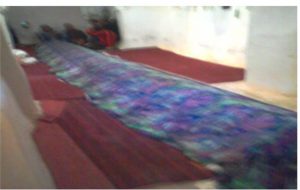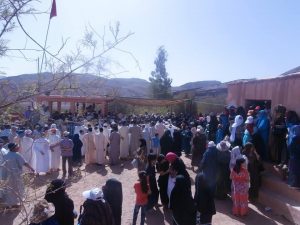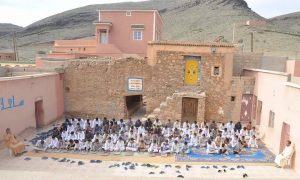“It was also rumored and spread among the people of Souss that those mountains, that is, the barrier between their country and the deserts of Morocco with their qiblah, are the burial places of three of the prophets.” This is what Muhammad bin Jaafar al-Kettani wrote in 1849, revealing, for the first time, an unfamiliar information that was not widely spread even among Moroccans.
The names of these “prophets,” as indicated by al-Katani in his book, are: “Our Master Daniel,” “Our Master Shnaul” and “Our Master Hezekiel.”
A Prophet in The Outskirts of Tata
There, deep in the southern city of Tata, specifically in the town of “Isafin”, an unfamiliar tomb rests. The people of the area call it “the shrine of the Prophet of God”. They also call him “Sir Ezikiel” or “Ezikiel”.
They say that he was among the prophets who were sent in the East to the Hebrews, before he traveled thousands of kilometers away, and was buried in a simple town located in the south of the “Souss” region, which is inhabited by a large part of the Berbers of Morocco.
“Sidi Hazkel” or “Sidi Welkanas”, as it is called by the general public in the region, “its length of more than seven meters raises many questions about its history and origin. It is not the only one in the area, but there are other tombs of approximately the same length,” says Rashid Krayed, Professor researching the secret of the “prophets” of this region.

Tomb of Prophet Ezekiel
He added: “But it is the only dome over which a dome has been erected, where dozens of residents nearby (the Ait Fid tribe) gather every year during the summer in the middle of the road between the Isafin community and the Tasawt roundabout in Tata province. Some went to say that he is from the Children of Israel, as they considered him to be the Prophet of God, Ezekiel.
The Land of Messengers of Allah
Researcher Rashid Karaid points out that the common belief among the residents of the area is that the Prophet Ezekiel buried here is the reason for the blessing of the area despite its attraction and drought. The reason, he says, is that he is the prophet who was mentioned in the Qur’an in the story of a man who passed by a dead people and God revived them.
Indeed, al-Tabari interpreted this verse [Verse 243 of Surat Al-Baqarah] as referring to the Prophet Ezekiel:
{أَلَمْ تَرَ إِلَى الَّذِينَ خَرَجُوا مِنْ دِيَارِهِمْ وَهُمْ أُلُوفٌ حَذَرَ الْمَوْتِ فَقَالَ لَهُمُ الله مُوتُوا ثُمَّ أَحْيَاهُمْ إِنَّ الله لَذُو فَضْلٍ عَلَى النَّاسِ وَلَكِنَّ أَكْثَرَ النَّاسِ لَا يَشْكُرُونَ}
For his part, the head of an association that oversees the annual “Prophet Ezekiel” season, Masoud Ait Issa, says that “Prophet Ezekiel is one of the prophets of the ancient East, and he did not know the reason for his coming and staying in the Far Maghreb.
Season of “My Master, Prophet of Allah”

Annually, every August there is a season in this region. Khaled Al-Ghazali, a resident of the area, told “Aswat Magharebia” that despite the severe heat in this part of Tata at that time of the year, a large number of visitors come to seek blessings and pray to God Almighty, begging for one of the prophets, perhaps God will answer their prayers in honor of this Prophet, especially the people of the region who settled in distant regions.”
Researcher Rashid Kreid says that special rituals are practiced during this season: “People slaughter an animal to honor the guests of the season. We call it ‘the favor’, and it is a duty in the culture of the people in the region, as they have to welcome the season’s guests, feed them and have ties of kinship.”

The place is also distinguished by the presence of an ancient school built in the past, associated with the shrine of the “Prophet Ezekiel” and named after him. Its director, Abdullah Arsa, says that “the school was famous for its association with the tomb of the Prophet Hazel. Students from different regions of Tata, Tiznit, Al-Bouj and even Tinghir are presented here. The Qur’an is preserved here and the sciences related to it are studied.”
This ancient school is found in the lists of the Ministry of Awqaf and Islamic Affairs for ancient education under the name “Sidi Hazkel” school, but there was no reference to the fact that this area was buried.
Sunna Files Free Newsletter - اشترك في جريدتنا المجانية
Stay updated with our latest reports, news, designs, and more by subscribing to our newsletter! Delivered straight to your inbox twice a month, our newsletter keeps you in the loop with the most important updates from our website












